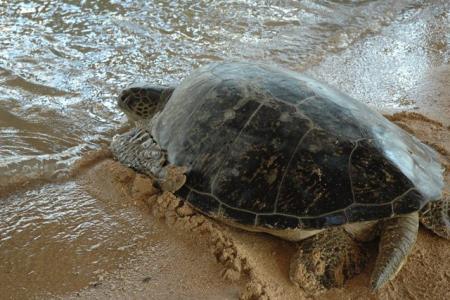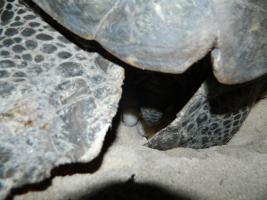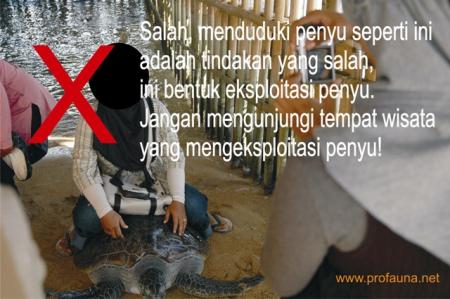Sea Turtle Observation Guidelines
By ProFauna Indonesia
All sea turtle species in Indonesia are protected by Law no. 5 of 1990 and Government Regulation no. 7 of 1999. There are 7 species of sea turtles in the world (some experts even claimed that there are 8 species), 6 of which live in the waters of Indonesia, namely:
- Green Sea Turtle (Chelonia mydas)
- Olive Ridley Sea Turtle (Lepidochelys olivacea)
- Hawksbil Sea Turtle (Eretmochelys imbricata)
- Leatherback Sea Turtle (Dermochelys coriacea)
- Loggerhead Sea Turtle (Careta careta)
- Flatback Sea Turtle (Natator depresus)
 The Loggerhead and Flatback sea turtles can be found in the waters of Indonesia, but there is no scientific proof yet if they nest upon Indonesia's islands. Below are the other two species that does not live in Indonesia:
The Loggerhead and Flatback sea turtles can be found in the waters of Indonesia, but there is no scientific proof yet if they nest upon Indonesia's islands. Below are the other two species that does not live in Indonesia:
- Kemp's Sea Turtle (Lepidochelys kempii). Its original habitat is in the coast of Mexico, and it is categorized as the most endangered and protected in the world. Some experts claimed that it is the smallest amongst all sea turtles.
- Black Sea Turtle (Chelonia sp). Actually its name is still debatable, even among experts, whether it is in the same genus with the Green Sea Turtle. This species has similar identification keys as the Green Sea Turtle, only the color is darker.
As species protected by the law of Indonesia, as well as international laws, then every citizen is responsible to conserve sea turtles and treat them with care. Sea turtles and their babies (called 'hatchlings') cannot be kept as pets, be commercialized, and be exploited (for example by carelessly sitting on top of its shell when taking pictures at tourism sites). Here is a basic knowledge and guidelines to observe sea turtles:
Facts about Sea Turtles:
- All sea turtle species are facing extinction if they do not properly protected. It is not true that the number of sea turtles is still abundant.
- Sea turtles breathe with lungs. When sleeping, they can stay underwater for as long as 4 hours (some experts say 7 hours), while when they are awake they have to go above the surface to take a breath every 30 minutes. However, if they are stressed by getting caught up in fishing snares, they might fall unconscious only in 10 minutes.
- Plastic wastes are very dangerous for the lives of sea turtles, especially when the sea turtles mistake plastic wastes for jellyfish, their favorite menu!
- Sea turtles will always return to the beach where they hatched to nest and lay their eggs. When the beaches are damaged, then it is most likely that they will not return there anymore.
What You Can Do:
There are several things to note carefully when you are around the habitat of sea turtles, or even in front of a sea turtle:
When you are underwater:
- careful when riding a motorboat, especially the speedboat. Boats might strike sea turtles and kill them. The worst scenario might be the turbines shred sea turtles into pieces.
- When you are underwater, maintain your distance with the sea turtles. Make sure that you do not scare, surprise, or disturb them while they are resting, sleeping, or eating.
- If you want to watch closely, approach them very carefully and move away once they show a sign of fright.
- Never spear, catch, disturb, play with, and sit on top of a sea turtle!
- Experts strongly forbid anybody to touch or feed sea turtles.
- Do not litter. Wastes, particularly plastic wastes, are very dangerous for sea turtles because they might easily mistake the waste for jellyfish.
When you are on a beach:
- Be careful not to damage a sea turtle nest! Avoid riding vehicles, doing sports, playing, and camping around sea turtle nesting site.
- Watch your campfire! Lights from a burning campfire will easily attract hatchlings to come closer, but they could die very soon from the heat.
- Do not leave large stuff such as chairs, tables, cooling box, etc. in a beach where sea turtles land because it might upset them and rescind the nesting/eggs-laying process.
- Keep your pets away, especially dogs, because dogs can be real threat for the eggs and hatchlings.
- When you are on a beach, keep your lights as dim as possible, red light is preferable. Bright lights might distract and disorientate hatchlings, which cause them to turn around from the water and walk towards the land instead.
- Cover your lights so that it is not visible from the ocean, because sea turtle mothers who are about to lay their eggs are very afraid of lights.
Guidelines to Observe Sea Turtle on Eggs-laying
 Observing sea turtle mother on eggs-laying process is a very rare and priceless experience. However, doing it without any knowledge and guidelines could cause harms to the sea turtle. Follow these simple rules, for the good of the sea turtle and the eggs:
Observing sea turtle mother on eggs-laying process is a very rare and priceless experience. However, doing it without any knowledge and guidelines could cause harms to the sea turtle. Follow these simple rules, for the good of the sea turtle and the eggs:
- Minimize making noise, stay calm and move around carefully.
- Do not approach sea turtles who just landed on the beach, for at such time they become highly alert. They might be easily frightened and turn around back to the sea.
- Sea turtle mothers must be left alone, do not be too close to them.
- Minimize using flashlights, use the red lights if possible. Never point the light directly to the the sea turtle!
- Step back slowly if the sea turtles show any sign of fright.
- Never disturb or play with hatchlings.
- Do not deliberately impair sea turtle nests and eggs.
- Do the observation no more than 30 minutes.
- Do not take pictures using flash, especially before the sea turtle mothers lay their eggs. Camera flash would frighten ans scare sea turtles off.
- Take pictures only from behind the sea turtles. Camera flash might temporarily blind them and confuse them as they find their way back to the sea.
About hatchlings:
- When hatchlings look confused by the lights coming from houses, hotels, or vehicles, you can help them by blocking the lights while staying behind the hatchlings. Meanwhile, have somebody guide the hatchlings towards the waters by leading them to walk towards the waters using flashlight. hatchlings will follow the flashlight, maintain the guidance until they reach the water.
- Do not disturb, touch, or lift hatchlings in order to get them into the water. They have walk their own way.
- Do not take photos of hatchlings who hatch at night using flash, because they are very sensitive of lights.
For further information about sea turtle observation guidelines, please contact ProFauna Indonesia by email to: international@profauna.net

